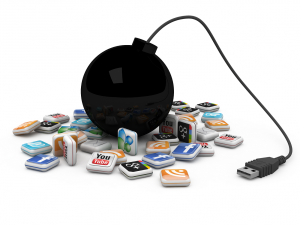When 9/11 took place, social media was still fresh and in the infant stages. To receive the news and to watch the events unfold, Americans and people across the nation were glued to their TVs, radios, and newspapers. Now, in 2017 social media is a way of life for many. It has been implemented in our everyday lives and it appears as though it will not disappear anytime soon. In addition to many terrorist attacks that have followed since then.
The use of social media and terrorist attacks sparked controversial debate amongst government officials, politicians, citizens, and more. Government across the world are feuding with technology companies to decide the future of the internet. The UK government is actually leading a battle to force tech companies to delete content at will, an entity that is crucial for counter-extremism projects but which experts explain will lead to censorship and could potentially put people at great risk of attack(s). As a result of this, many countries are following the UK in an attempt to decide what is published online. In recent years, the Government has focused more on removing the ability to discuss or spread terrorist propaganda from the internet. That marks a major withdrawal from its previous abandoned strategy, which had originally focused on the security tools that were being used to protect messages.
Initially, this shift came when Theresa May (U.K’s prime minister), attempted to force tech companies to stop using strong encryption so that intelligence agencies could read messages. This resulted in severe pushback from tech companies, who argued it wouldn’t be possible to break security just for terrorists without endangering all of their users.
A growing agreement on that argument has led the Government to instead focus on terrorist content, not the delivery tools used to spread that content. And so, the focus has shifted to social media and tech companies like YouTube and Facebook, rather than messaging companies like WhatsApp and Apple.
Additionally, the U.S, who allows tech companies a substantial amount of freedom has revealed that it wants to limit what they’re allowed to publish, and may follow U.K’s model.
Despite all of the criticism, internet companies are doing more to crack down on terror and making that effort as public as they can. Facebook, Google, Twitter, and YouTube this summer founded the Global Internet Forum to Combat Terrorism. It’s supposed to help create new technological solution tools to detect bad content and pass those findings to smaller companies.
Google, for instance, has been working on counter-speech work, which attempts early intervention before people have actually been radicalized, and tries to change people’s mind when they begin searching.
If people appear to be looking for terrorist content or propaganda, like searching “how to join Isis”, for example, then Google will display content intended to change that person’s mind. Google has also given out Adwords grants, so that non-governmental organization can buy ads on problematic searches for free, on which they can put links to counter-extremist content.
But the problem isn’t practical or technical it ultimately comes down to questions about what exactly tech companies are and what they do. Social media companies tend to refer to themselves not as publishers (which would make them liable for any content hosted there) but as platforms, a designation for which there is a much less clear regulatory and ethical framework.
This reminds me of the time in class when Bart explained to us that no one controls the internet. I also remember having this talk with someone explaining who should be held accountable for details about potential terrorist attacks posted on social media sites, Reddit, online forums, the dark web, etc. It’s interesting to see that countries are trying to push effective strategies on how to deal with terrorism online. I think Twitter is a huge social media site that has many terrorist organizations trying to recruit people such as; ISIS, white supremacy groups, etc. There is a lot of controversy with how they handle suspending/deleting accounts that post hateful messages that can incite violence. What do you think?
Do you agree with the U.S joining the fight to hold social media platforms accountable for stopping potential terrorist attacks? Or do you think this could lead to larger damage and more attacks than we ever expected?
Griffin, A. (2017, Oct., 23) Tech Companies and Governments Fight Over Who’s Responsible For Stopping Terror Attacks. Retrieved from:





